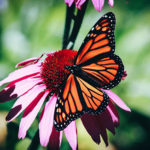
Through highlighting edges of your photo, you also highlight its details. The method of unsharp mask and others like the difference of Gaussians increase the change in brightness close to each step. This technique’s standard version adds a bright halo along the bright edge of the step and a dark halo along the dark edge. Depending on what effect you’d like for your image, there are advantages in just using one or the other. Using both may not do very much to improve your image, though.
There are several advantages of using any of the effects for the edges on real images. One is that it reduces interference between steps or detail and the haloes from other, nearby steps. Another thing, the light or dark haloes make other features of the image stand out better from the background.
Start doing this effect on your images using Photoshop by following several procedures:
1st step is duplicate the layer holding the image
2nd step – apply the conventional unsharp mask
3rd step – set the layer blending mode to “Darken” or “Lighten”.
However, you must understand that this only works for 8 bit per channel images – those that can be put into layers but it could function also on 16 bit per channel pictures with Optipix plug-in that allows direct selection of dark or light edges.
If you are not sure about which edge halo to use, there are general rules regarding such:
1. On light background tones, light edges don’t show up well and vice versa on dark ones.
2. The halo should lie on the background, not on the foreground. This technique helps the feature stand out without having to change its brightness values.
Sometimes the following rules are in conflict. It is necessary, then, to try several combinations to decide which is best. You can try both edges, light edges only, dark edges only. You can experiment since different regions of your image may call for different answers.
As you experiment for the best results, you’ll come to know that using unsharp mask filter may drive you to add too much additional local contrast. Understand that though adding some local contrast can make a bland image turn into a good one, adding too much creates a disaster. Take care not to add too much and make the image appear more like caricatures than photos. Remember that what looks best on the computer screen may not be the same in print since the process somewhat compresses contrast and blurs detail.
About The Author
Lala C. Ballatan is a 26 year-old Communication Arts graduate, with a major in Journalism. Right after graduating last 1999, she worked for one year as a clerk then became a Research, Publication and Documentation Program Director at a non-government organization, which focuses on the rights, interests and welfare of workers for about four years.
Book reading has always been her greatest passion — mysteries, horrors, psycho-thrillers, historical documentaries and classics. She got hooked into it way back when she was but a shy kid.
Her writing prowess began as early as she was 10 years old in girlish diaries. With writing, she felt freedom – to express her viewpoints and assert it, to bring out all concerns — imagined and observed, to bear witness.
For comments and inquiries about the article visit http://www.ucreative.com
Like This Article?
Don't Miss The Next One!
Join over 100,000 photographers of all experience levels who receive our free photography tips and articles to stay current:






Leave a Reply